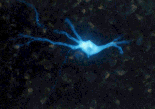| Sponsored by Wake Forest University School of Medicine and National Families in Action | |||
| Glossary - P | |||
| This glossary comes from False Messengers: How Addictive Drugs Change the Brain, by David Friedman, PhD, and Sue Rusche, Harwood Academic Publishers, Amsterdam, The Netherlands, 1999. A
| B | C
| D | E
| F | G
| H | I
|
|
|||
| P Parallel processing When various cortical fields and nuclei work together simultaneously, each on a small part of a big information-processing job. Paranoid schizophrenia A severe form of mental illness typically characterized by delusions of persecution and hallucinations. This condition may be induced by binge use of stimulants. Parkinson's disease A disease in which dopamine-containing neurons die. It produces severe impairments in movement, cognitive function, and emotions. PCP (phencyclidine) PCP has an array of effects. Originally developed as an anesthetic, it may act as an hallucinogen, stimulant, or sedative. Peptides Small protein-like compounds made of amino acid building blocks. Perception The conscious awareness of sensory inputs, internal states, or memories. Periaqueductal gray matter A set of nuclei deep within the brain stem that are involved with visceral functions. It also plays a role in the development of physical dependence on opiates. Pharmacodynamics The study of the mechanisms of actions of a drug, the relationship between how much drug is in the body and its effects. Pharmacokinetics The study of how the body absorbs drugs, how they are distributed throughout the body, and how the body gets rid of drugs. Phencyclidine See PCP. Physical dependence Changes that the brain and body undergo as they adapt to the continued presence of high doses of drugs. Because of these changes, the brain and body eventually come to require the presence of the drug to work properly. Placebo An inactive substance. Plasticity The capacity of the brain to change its structure and function within certain limits. Plasticity underlies brain functions such as learning and allows the brain to generate normal, healthy responses to long-lasting environmental changes. Positive reinforcement Something that increases the likelihood that the behavior that elicited it will be repeated. Positive reinforcement is rewarding, and we typically perceive it as pleasure.
|
|
Positron emission tomography (PET) A technique for measuring brain function in living human subjects by detecting the location and concentration of tiny amounts of radioactive chemicals. PET scanner The machine that detects the radioactive chemicals used to measure brain functions. Prefrontal cortex The part of the cerebral cortex at the very front of the brain. It is involved with higher cognitive and emotional functions including short-term memory, learning, and setting priorities for future actions. Presynaptic neuron A neuron that releases neurotransmitters into synapses to send messages to other neurons. Prevention Stopping drug use before it starts, intervening to halt the progression of drug use once it has begun, changing environmental conditions that encourage addictive drug use. Primary reinforcers Stimuli, such as food and water, which produce reward directly, with no learning about their significance or other intervening steps required. Most drugs of abuse are primary reinforcers. Projection neurons Neurons (usually excitatory) that send their axons away from the local vicinity to communicate with other parts of the brain. Proteins Large molecules made up of amino acid building blocks. Psilocybin A natural hallucinogenic drug derived from a mushroom. It acts on the serotonin receptor. Psychedelic drug Drugs that distort perception, thought, and feeling. This term is typically used to refer to drugs with actions like those of LSD. Psychoactive drug A drug that changes the way the brain works. Psychological dependence When drugs become so central to a user's life that the user believes he must use them. Psychosis Severe mental illnesses characterized by loss of contact with reality. Schizophrenia and severe depression are psychoses. Psychosocial therapy Therapy designed to help addicts by using a combination of individual psychotherapy and group (social) therapy approaches to rehabilitate or provide the interpersonal and intrapersonal skills needed to live without drugs.
|
|
| Home | For Journalists | For the States | Science Update | Links | Glossary | About |
Last Revision
info@addictionstudies.org

